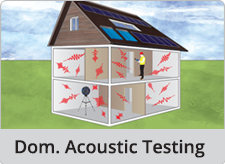Offices Nationwide

Air Testing & Leakage
We can offer additional services at discounted rates along side our tests! These are Sound Testing and Part F. Ask our Consultants for more

Sound Absorption
The loss of sound energy when sound waves come into contact with an absorbent material such as ceilings, walls, floors and other objects...more
Newbury - Room Integrity Testing - 020 3390 0301
The office that covers this area is: London
Phone Number: 020 3390 0301 Email: newbury@e2consultants.co.uk
Room Integrity Testing
What Is It?
Room Integrity Testing is required for any gaseous fire suppression system. Gas fire suppression systems work by releasing a gas agent into an enclosure and the gas then either reacts with the fire or reduces the oxygen level which then suppresses or extinguishes the fire. For a fire suppression system to work correctly the enclosure needs to hold the gas for a set period of time.
How Does It Work?
By pressuring a room with a door fan test and then measuring the pressure release period with sensors to a pre-determined level, we can determine if the room has enough integrity to hold the type of gas agent the fire suppression system is designed for. This test will predict how long it will take for the gas to descend to a certain level without having to carry out a discharge of the system, which can be costly and disruptive.
Will The Test Disrupt My Business?
No - you and your staff can still work while testing is taking place. The only thing that may affect workflow is the door fan equipment that must be fixed to the main door and will in turn stop people being able to enter or leave the room during this time.
Testing Procedure
Upon arriving at site and unloading the equipment, one of our consultants will inspect the room where the test will take place. Room measurements will need to be taken at this time if they have not been done prior to our site visit. The door fan kit will be set-up by our consultant in the most appropriate door in the room, usually the main door. There will be no requirement for the removal of any doors to make room for our testing equipment as we aim to make as little impact on the environment as possible.
What are the Standards and Guidance?
The main standards that recommend Room Integrity Testing on commissioning of a system and the annual re-testing of an enclosure are BSEN15004, ISO14520, BAFE SP203-3 and NFPA 2001. These are UK and US national and international standards that provide guidance on how to carry out the test and the frequency of re-testing.
The test will depressurise and pressurise the room whilst using computer software to collect the data. Once complete, our consultant will check the data against target data provided by the client. If the result is lower than the target score then our consultantrs will beging to identify the problem areas.
All of our consultants are trained to use thermographic cameras to help identify these leakage areas, these images will be sent to the client with a full test report as well as the snag list. The snag list will outlineall the identified leakage areas that will need to be addressed along.
Will I Need To Re-Test The Room At A Later Date?
Any room, particularly those housing Electronic Data Processors, often get disturbed by service and general building work. General wear and tear from using a room can result in a small hole being made, or even if the room size changes, then another test will need to be perfomred. According to British Standards, a Room Integrity Test should be carried out at least once a year to ensure your gaseous fire suppression system will work correctly, should it ever need to be activated.
Our other services include:
Room Integrity Testing can also be known as:
Server Room Testing, Fire Suppression Testing, Fire Suppression Room Integrity Testing,


Copyright 2025 E2 Specialist Consultants Limited
Company No. 06728970









































